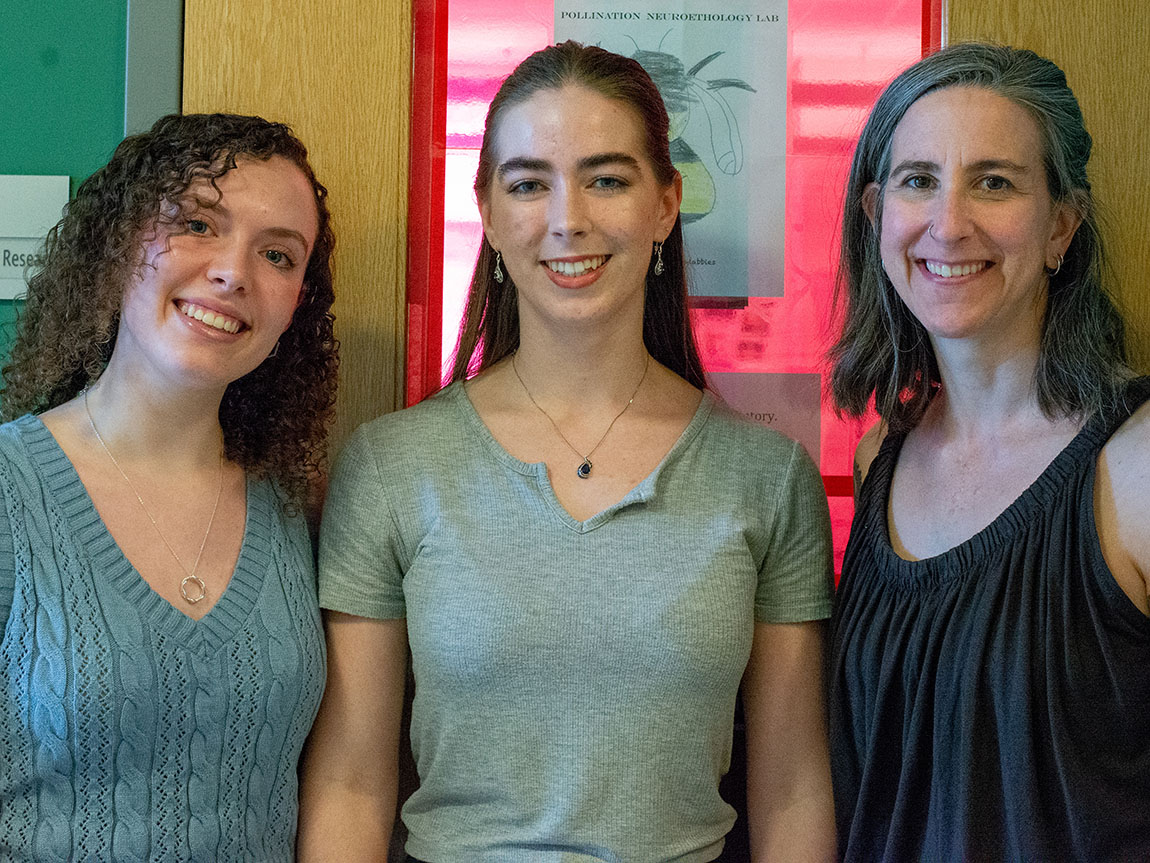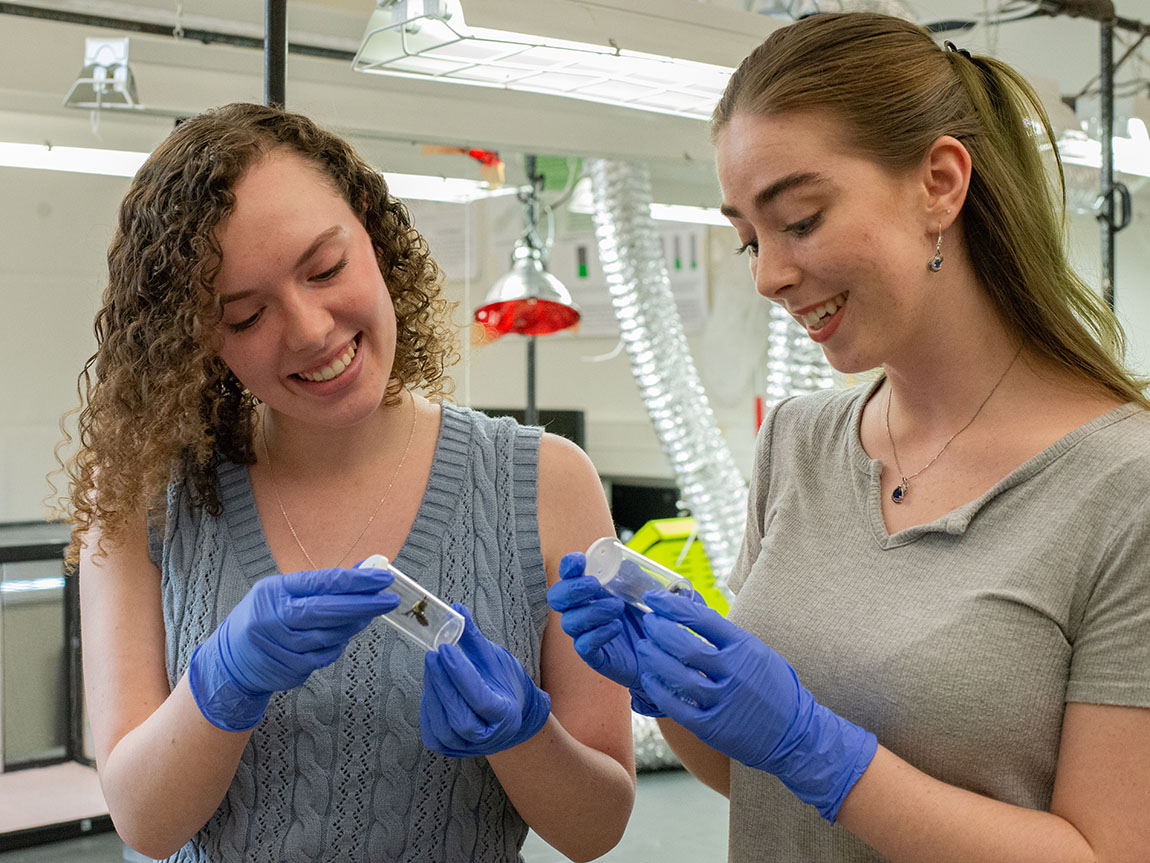The National Science Foundation (NSF) Awards a $292,118 Grant to Professor of Neuroscience Jordanna Sprayberry
The incredibly competitive mid-career advancement award will allow Sprayberry and her undergraduate research students to open up a new line of inquiry in her lab, which explores how the sensory processing of pollinators drives behavior.By: Meghan Kita Wednesday, April 17, 2024 01:21 PM
 Paige Henderson ’24, Rebekah Ayre ’24 and Professor of Neuroscience Jordanna Sprayberry outside Sprayberry's lab during summer research in 2023. Photos by Lizard Foley ’24
Paige Henderson ’24, Rebekah Ayre ’24 and Professor of Neuroscience Jordanna Sprayberry outside Sprayberry's lab during summer research in 2023. Photos by Lizard Foley ’24Last month, the National Science Foundation (NSF) notified Professor and Chair of Neuroscience Jordanna Sprayberry that it would be awarding her a $292,118 grant. Sprayberry will use the NSF Mid-Career Advancement award to purchase equipment for a new kind of experiment in her lab: recording the activity of neurons in bumblebee brains while they respond to different kinds of odors. In the short term, these experiments will build knowledge about how odor information is written into brains. In the long term, this is a step toward trying to generate a way to predict whether specific agrochemicals would disrupt bees’ ability to find and pollinate flowers.
“As a question-driven scientist, new experiments in my lab evolve from the results of previous experiments. Lately, I have not been able to run the logical next experiment because I didn’t have the right equipment. This grant removes those roadblocks,” Sprayberry says. “Once I start up these new investigations, I’ll be able to train my research students on modern electrophysiology techniques, which is really exciting.”

Sprayberry’s lab investigates how the sensory processing of pollinators (specifically bumblebees) drives behavior. One topic she and students have been exploring is how odor pollution might disrupt bumblebee foraging. They have found that fungicide odors are particularly disruptive to bumblebee behavior. In trying to understand why, Sprayberry developed a computational tool that can represent complex odors and how they are changed by pollution.
This computational tool doesn’t work for simple odors, because the way that the brain, in bumblebees and in humans, recognizes simple odors is different from the way it recognizes complex odors. Complex odors are encoded “configurally,” which is when the whole is not recognizable from the parts. When a person smells a rose, they don’t smell the 400+ individual molecules that make that scent. Simple odors are encoded “elementally”: “If you mix up a bottle with ammonia and alcohol to clean a mirror, when you spray it, you can smell each scent you added, because your brain is tracking the elements of the blended odor,” Sprayberry says.
The equipment this NSF grant will purchase will use electrodes that allow Sprayberry and her students to record from multiple neurons simultaneously. This will allow them to determine when the brain switches: When does an odor become complex enough that the brain encodes it configurally instead of elementally?
“As a question-driven scientist, new experiments in my lab evolve from the results of previous experiments. Lately, I have not been able to run the logical next experiment because I didn’t have the right equipment. This grant removes those roadblocks. Once I start up these new investigations, I’ll be able to train my research students on modern electrophysiology techniques, which is really exciting.”
—Professor of Neuroscience Jordanna Sprayberry
The end goal, Sprayberry says, is to be able to “make a comprehensive geometry that describes odor-driven behaviors in bumblebees.” One possible application of this would be related to agrochemicals: She could predict whether an agrochemical formulation would disrupt foraging behavior in bumblebees and offer advice to farmers to avoid damage to pollinator behavior.
Sprayberry typically has about six student collaborators in her lab at any given time, some of whom are working on established projects and some who launch their own projects. Several students from the Sprayberry lab have co-authored papers based on their undergraduate research.
The NSF grant will support not only the purchase of the new electrodes but Sprayberry’s training this summer to set them up and use them. She estimates it will take each of her student collaborators 10 to 20 hours of training to learn how to use the electrodes, a relatively short period of onboarding compared to other neuroscientific methods. The electrodes will open up multiple lines of inquiry for Sprayberry and her students that were not available previously.
“I look forward to seeing the new studies from Dr. Sprayberry’s lab and the parallel impact on students’ understanding of how their course work relates to real-world, complex problems such as sustaining pollinators who are key players in food production and healthy environments.”
—Provost Laura Furge
“Dr. Sprayberry has trained generations of student research assistants in her work. The award from NSF recognizes not only her tremendous past successes as a scientist and as a mentor, but also sends a signal that the best is yet to come,” says Provost Laura Furge. “I look forward to seeing the new studies from Dr. Sprayberry’s lab and the parallel impact on students’ understanding of how their course work relates to real-world, complex problems such as sustaining pollinators who are key players in food production and healthy environments. Dr. Sprayberry finds great joy in this work and represents the best of what it means to be a teacher-scholar.”
